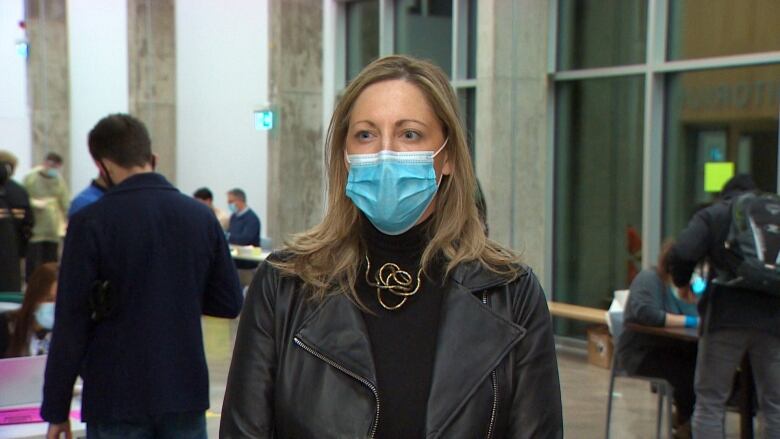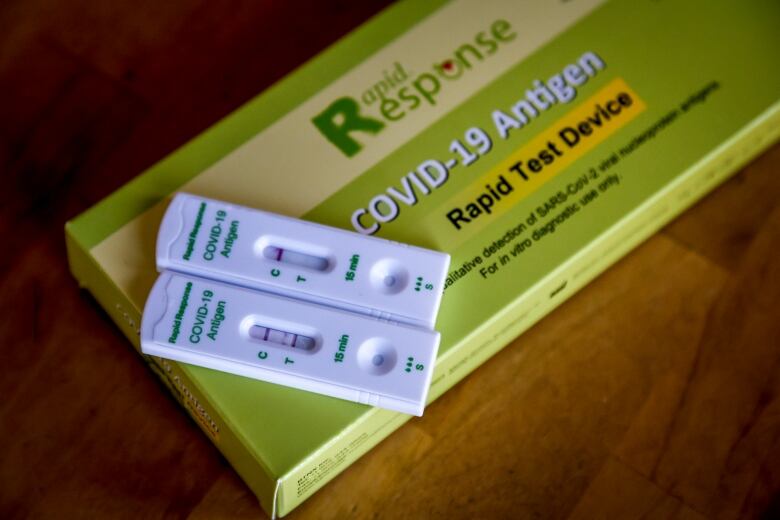Rapid test only when symptomatic, and use a mirror when swabbing, experts say
Rapid tests don't have the certainty of PCR, but they're the best available option as cases rise

Over the last two years, clinical PCR tests have played an important role in New Brunswick's efforts to control COVID-19. You have symptoms, you get tested.If it's negativeyou getonwith your life, if it's positive you self-isolate.
But, with an exploding case count, the province is now only allowing PCR testing for people over 50 or for younger people who are immunocompromised.That means the certainty of a PCRtestis no longer available to most New Brunswickers.
The alternativeprovided by the province is therapid testat-home screening tools that provide results in less than an hour. They're less reliable, and there's more room for error if they're done at home.
On top of that, only people with symptoms are eligible to pick those tests up, meaning they're not as freely available as they used to be.
So what is their purpose, and how do youuse them properly?

Chief Medical Officer of Health Dr. Jennifer Russell said rapid tests are a good alternative to PCR tests in young healthy people because the focus these days is preventing hospitalization.
Now that 83 per cent of eligible people are fully vaccinated, younger healthy people are less likely to be hospitalized and don't need the extra measure of a PCR test and close Public Health attention, she said.
"The risks are higher if you're over the age of 50, and the PCR test has our public health folks providing follow up as well," she said.
She said as case numbers rise, it's not possible to give everyone a PCR test.
'It reduces your risk. It doesn't take it away'
Russell said the purpose of the rapid tests is to limit the spread of COVID-19, but they're not bullet proof.
Dr. Lisa Barrett, an assistant professor at the Division of Infectious Diseases at Dalhousie University's Department of Medicine, said rapid tests are useful when showing a positive result, but a negative test doesn't mean you're not carrying the virus.
"A negative test tells you that you're less infectious that day. It reduces your risk. It doesn't take it away," she said. "And for the next little while, with tests being rarer and people wanting to use them to diagnose COVID, it does make sense to use them when you have symptoms."
Only test when symptomatic
Russell said people should only test if they have symptoms such asa sore throat, runny nose, fatigue, cough, loss of taste or smell.
This is different from the holiday guidance of "rapid test before you gather." Russell said the change is to conserve stock.
"We don't really have the volume we would like to be able to test asymptomatic people at this time," she said.
The province will be getting 4.7 million rapid tests from the federal government next week, Russell said. It's not clear if that will change the guidance once those tests get to the province.
People who have been in contact with a known case will still have to self isolate, Russell said, and that's not affected by the new testing rules.
"When somebody gets a positive result, all the members of their household need to isolate and only if they develop symptoms would they need to get tested," she said.
Nose or back of throat, what's the best way to take a rapid test?
Barrett said there are three areas to swab when doing a rapid test. Most tests recommend swabbing the nostril or the nasopharyngeal area. Some people have been swabbing the back of the throat, which Barrett said is not proven to provide more accurate results.
Barrett said people should stick with the recommendation on the box or in rapid test inserts.
"Adding in random sites is not generally helpful, and to be honest, most people swab the side of their cheek and not their throat," she said.
In terms of the nose, Barrett recommends people use a mirror.
"Sometimes you think that that little swab is all the way in there, the fuzzy part in the end, but it's not," she said. "Make sure that the swab is inside your nose."
She said the swab should be touching the sides of the nose, which is where the virus lives.
"So swirling and touching against the inside part of your nose, not just the air in your nose or the hairs, is good. Make sure you do that and do it well," she said.
"Going further back than they suggest is not really recommended at the moment in general, and you should get a good sample if you use a mirror to swab it inside your nose."
Public Health asks people to report their results online if they test positive.
What is the responsible thing to do when you have symptoms and test negative?
According to Russell, people are only obligated to self isolate if they have symptoms and test positive, or were close contacts of a positive case.
Barrett said this is a trend across the country.
But even if they're not obligated to isolate, people should still consider doing so, Barrett said, at least for the first two days.
"If you get symptoms, test the first day. If it's negative, retest again at 48 hours," she said.

She said the two days is an average, and some people could have COVID and not test positive in a rapid test for five days.
"That is why we tell people if you really do have symptoms and you're sick, stay home."
But that's not possible for everyone, which is why a rapid test is there to minimize the risk.
When it comes to gatherings, Barrett said only take the test before a gathering "if you're really, really, really in a situation where you have a vulnerable person and you have to see them."
With files from Information Morning Fredericton and Shift NB












_(720p).jpg)


 OFFICIAL HD MUSIC VIDEO.jpg)
.jpg)



























































































